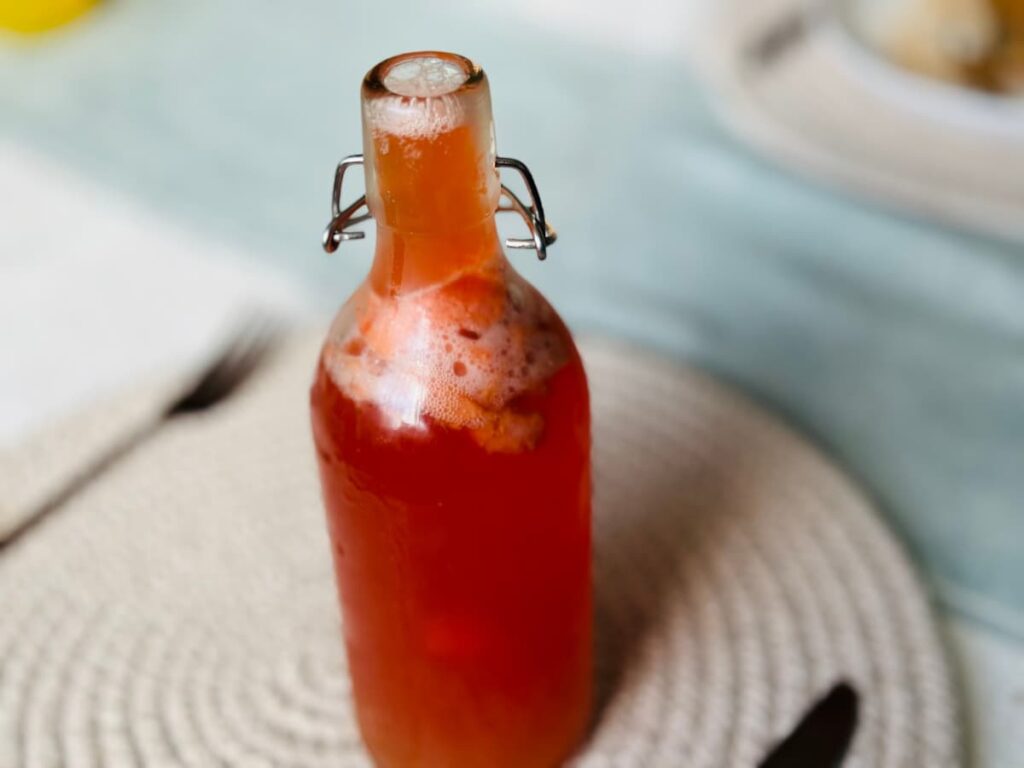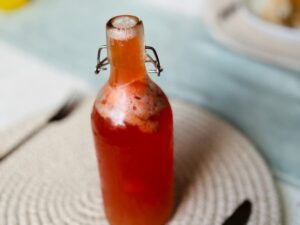Kombucha is a probiotic fermented tea drink with a refreshing fizz, But if you are making it at home, how do you get the ‘Fizz’? Lets take a look today at how to carbonate Kombucha.
And if you are new to kombucha, take a look at our Ultimate Kombucha Guide here

The wonderful fizz as you pop the stopper on that cold bottle of Kombucha is second to none!
When you’ve made it yourself, it’s even more satisfying!
But when it doesn’t pop…. Grrrrrrr
I mean, don’t get me wrong, it still tastes nice, but it’s more than a little disappointing.
So how can we avoid the crestfallen look and make sure we have bubbles?
How to Carbonate Kombucha – First ferment
It all starts with the first ferment.

I know this sounds simple, but did your kombucha actually ferment?
When I first started making kombucha, I had never tried it before! Can you believe that?!
I had heard so many good things about it and I knew I loved tea, so that was enough., I thought I’d just give it a go!
The problem was, I had no idea how it was SUPPOSED to taste! So I bought some plain kombucha to try. This did the trick, as I now knew what I was aiming for. (I actually like it a little stronger than store bought nowadays but that’s just preference)
So, to set you up for the best bubbles, try tasting your kombucha on the first ferment, to make sure the SCOBY (Symbiotic Colony Of Bacteria and Yeast) is doing it’s job and eating up the sugars in the tea.
It should taste like mildly sweet, but mainly sour tea. Again, preference plays a part. Always use a clean spoon and err, don’t double dip. We do NOT want to introduce bad bacteria into our ferments.
If it tastes good to you, it’s time to move on to the second ferment..
Second Ferment
Now, this is where the bubbles happen (or don’t)
The first ferment is open to the air just a little bit, for example covered in a muslin cloth, or a loose lid. This allows the gasses to escape while the ‘mother’ does the job of fermenting the tea.
Once it’s done that though, we are now switching, and we’re going to trap that gas, so it can carbonate the drink.
More Sugar???

Yes, but bear with me. This is for the bacteria to eat. They eat the sugar, give off the gas and carbonate the liquid. Now, I’ve tried different ways of doing this, including fruit juice, syrup, whole fruit on it’s own, but the best fizz, hands down, comes with sugar.
I’ve experimented with brown sugar too, and that works well. It also adds a nice flavour to the finished drink, but does affect the colour (my husband lovingly calls it dish water colour.., Cheeky!)
Once you have decided on your flavourings, (our favourites are listed below), and your sugar, you must make sure that the seals are clean and tight.
I use swing top bottles and I’ve noticed that if there is a little grain of sugar, or a splodge (technical term) of fruit on the rim or on the seal, then no bubbles! It may not leak, but it’s not tight enough to produce bubbles.
Cleaning the rims and seals with a vinegar soaked rag, like in canning, is a great way to clean them thoroughly.
Second Ferment Timing
Leaving them for long enough is often the main culprit in fizz-less Kombucha.

Every house, every kitchen is different, but guidelines say it can take anywhere from 3-10 days. I would say it can even take longer. You have to find what suits your tastes and your environment. I know that isn’t a very satisfactory answer, but it’s true!
I’ve watched Becky from the YouTube channel Acre Homestead say she ferments hers for 4 weeks on the first ferment and 3 days on the second. Whereas we have found we like it to ferment for a week each time. You really do have to try it and see.
If you try after a week by opening a bottle and there are no bubbles, leave the rest for a little longer. I can usually tell it’s ready by the little bubbles around the top of the liquid if I move it a little. ( I don’t advise shaking it, as you’ll end up with a big ole mess. Ask me how I know…)
Once you see those bubbles moving, you can put it in the fridge to chill and to slow the fermentation down.
Now, hopefully when you pop that bottle, it should fizz right up!
Some of our Favourite Flavour Combinations
- Strawberry and Lemon (Juice)
- Blueberry and brown sugar
- Ginger and lemon (my hubby’s absolute fave)
- Mango and raspberry
- Summer fruits (strawberry, raspberry, red currant)
- Blackberry and lemon
- Strawberry and ginger
I am waiting to try apple and ginger too in the fall, as I’m sure that will be a winner in our house.
In all of these instances, you can use fresh or frozen fruit, but the fresh fruit does seem to add a depth of flavour, as you’d expect.
So what are some of your favourite Kombucha flavours? Let me know in the comments below. Thanks friends, happy fermenting! x

